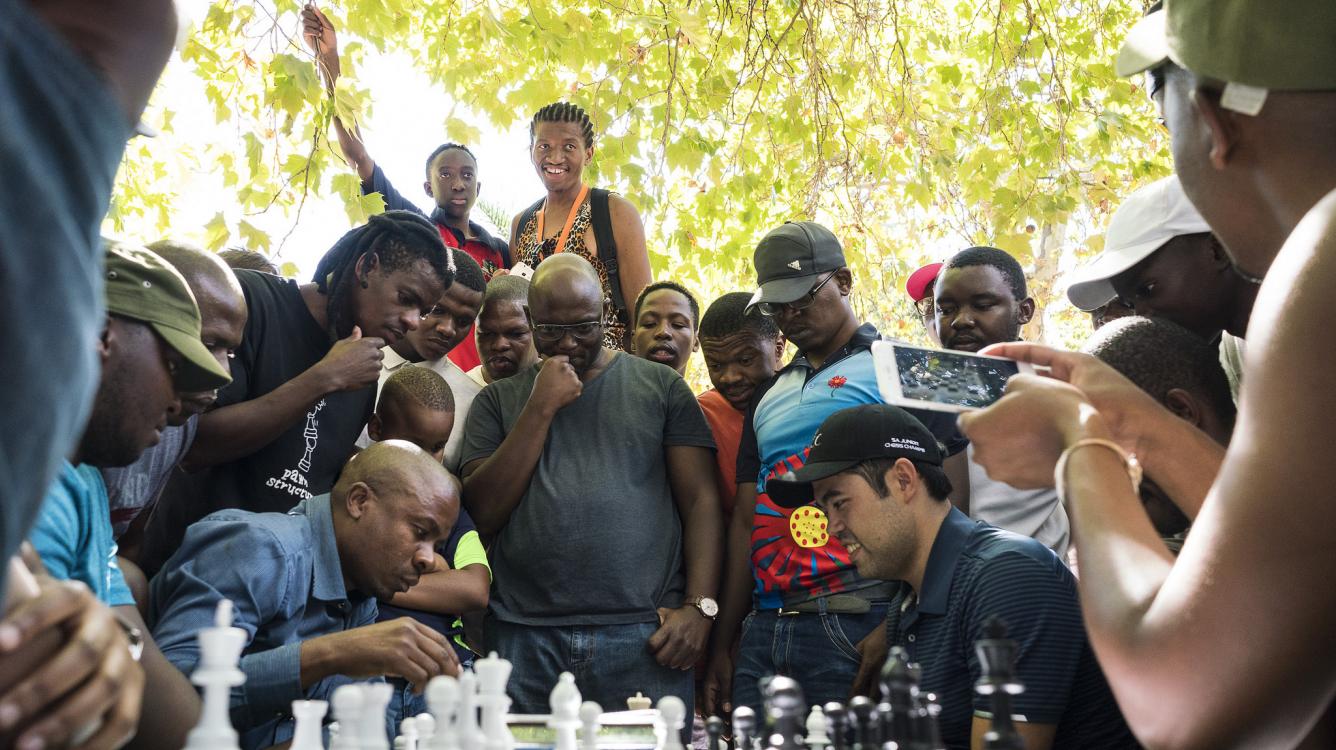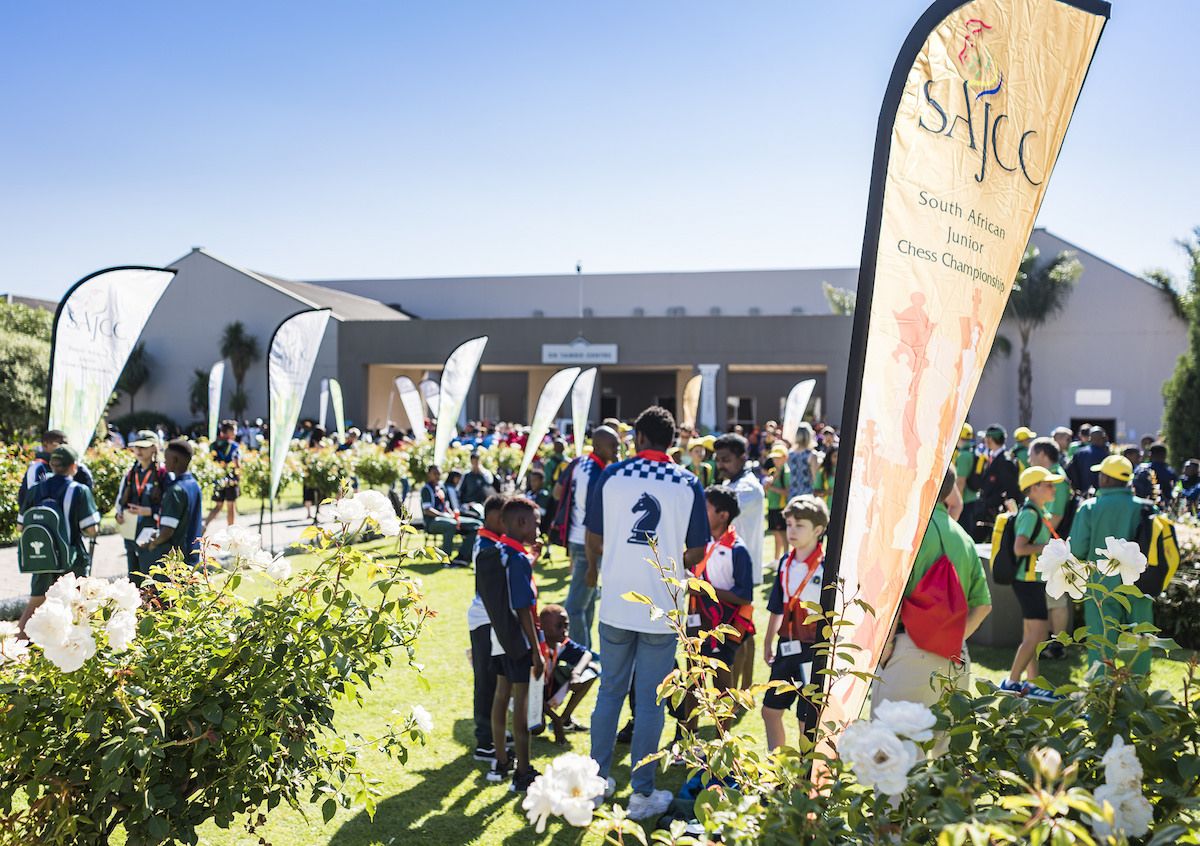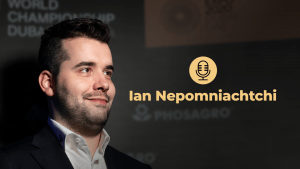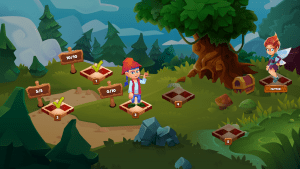
Nakamura Visits South African Chess Events
South Africa doesn't show up on these news pages often, but a flurry of events took place this month in Johannesburg. Local chess officials wanted to put their country more on the world chess map, and pulled out all the stops to do just that.
More than 2,500 scholastic players from all over the country converged to compete in the 2017 South African Junior Chess Championships (the event took place this January 3-12, during the kids' summer break, but the event officially crowned championship teams and individuals for 2017).

The end of summer break in South Africa means the beginning of the country's biggest chess event of the year. | Photo: Lennart Ootes/SAJCC.
During the London Chess Classic in December, South African organizers persuaded GM Hikaru Nakamura to join as the marquee guest. The super-GM participated in a variety of events, from the public finals of the Speed Chess Championship, to a 100-board simul, to an afternoon blitz session in a raucous downtown park. The well-traveled professional just cleared one million lifetime miles on United Airlines, but he had never touched African soil before this January (despite being able to see Morocco from the Gibraltar Chess Festival, where he is an annual player and often winner).
A Lekker One-On-One Match, Then Thousands of Kids
Before the gigantic team event took place under the intense African sun, Nakamura was the first to do battle. He played his Speed Chess Championship final in a hotel auditorium in front of a (paid!) crowd of several hundred, while GM Magnus Carlsen had the solitude of an empty room.

Every seat taken for watch the Speed Chess Championship final in person—the empty seats at top left were for this reporter's gear! | Photo: Lennart Ootes/SAJCC.
Is this the beginning of chess as an e-sport? Perhaps. Nakamura had of course agreed to this before traveling, and when given the option, he chose to face the crowd during the match as his moves were displayed on twin projection screens behind him.
This would also seem to be the first-ever high-profile chess match where the local smoked meat called biltong was on the player's platter. Even if the match didn't go his way, Nakamura developed quite an affinity for the South African treat.

Nakamura didn't net as many wins as he wanted, but just next to his mouse-moving hand is all the biltong he could care to eat. | Photo: Lennart Ootes/SAJCC.
The next morning, the kids came out to play the first of seven rounds in the team tournament. How did this differ from other large scholastic events around the world? The swaths of junior players wore matching team uniforms, with everything from colorful t-shirts to suit jackets and ties. Also, the teams were 10 players deep, much larger than the four-on-four for adult team matches.

The massive competition begins! | Photo: Lennart Ootes/SAJCC.
In addition to this Olympiad-type sartorial unison, the squads also came with crests of their local chess club or province—a real "Braveheart meets chess" moment.

Several Johannesburg Metro teams placed first, maybe because they remembered to hydrate (the summer temperatures reached 37C or about 99F). | Photo: Lennart Ootes/SAJCC.
Nakamura Makes a Braai Out of Park Players
Outside of his stepfather, Nakamura never had a traditional chess coach. His rise to the world's elite was thanks to both the internet and to games in the park. So, you might think he'd be right at home accepting an invitation to play the hustlers in downtown Johannesburg's Joubert Park. He readily agreed, but what was he getting into?
New York City this was not. Manhattan's Washington Square Park, with its iconic chess tables in the southwest corner, has benefited greatly from the city's property-value increases and general safety improvements in the last few decades. Joubert Park, however, is on the edge of Hillbrow, once a whites-only symbol of Apartheid, then a progressive mixed zone, but now one of the poorest neighborhoods in Johannesburg.

Standing-room only to watch the master. | Photo: Lennart Ootes/SAJCC.
Just Google the park's name and you'll inevitably come across stories with themes like "the city that once was" and other eulogies of the area's more placid times. As one player pointed out in a Facebook post that captured the excitement of the afternoon, GM Maurice Ashley didn't venture into the park on his visit to South Africa.
Nowadays, the park is vacated by even locals at night due to safety. No such drama ensnared Nakamura during his visit, at least none away from the chessboard (well, not counting one inebriated bystander who snuck a kiss on his neck as he was leaving).
The crowd initially regaled the grandmaster, then set about the task of trying to beat him. They parted way for him to enter the cave against the city's best blitz players.

The Southern Hemisphere version of Rensch-Vachier-Lagrave? Nakamura also tried his hand (and feet!) at giant blitz. | Photo: Lennart Ootes/SAJCC.
Nakamura offered 10-1 money odds (10 Rand to 100 Rand, or about $0.80 USD to $8.00 USD) and also 3-1 time odds. It wasn't his intention to win money, but as was explained to him by hosts, none of these games take place without some sort of wager.
As he began to dispatch one opponent after the other, the crowd elbowed its way in for a clearer view. Standing atop trash cans and bracing themselves with overhanging tree branches, the onlookers weren't interested in the traditional protocols of tournaments. Phones were on while heckling became a competition: "Are you on Facebook? I do not 'like' that move." One commenter to a video posted remarked: "The crowd is like a real-life Youtube comments section."
Only one player managed to scavenge a win from the visiting grandmaster. IM Johannes Mabusela, recent winner of the 2017 South African Closed Championship, mated a wayward Nakamura king as the American's time ticked away.
How do park locals celebrate the victory of a lifetime?
The visiting celebrity then got swift revenge on the country's new champion:
Here's the payback game:

IM Johannes Mabusela's victory was boisterous but short-lived after Nakamura got his revenge. | Photo: Lennart Ootes/SAJCC.
Nakamura also found himself in a tricky rules controversy that will not be new to frequent Chess.com news readers. Remember last year's controversial ending to the Canadian Championship? Nearly the exact same situation recurred in the park.
Nakamura, low on time, promoted a pawn but didn't replace it with a queen. After a few plies, his opponent asked what the rules stipulate. (Note: on the way to the park, this reporter asked our hosts if the local players would try to claim wins based on pedantic rules, and we were told they would not!) Nakamura kept calm, waiting for the crowd to hush, then pointed out that he can leave the pawn on the board if his opponent is holding the intended promoted piece (the queen).
Essentially, Nakamura was going for the "Nikolay Noritsyn Rule"—the Canadian IM tried the same justification for an upside-down rook in his rapid-game playoff. The problem is, that's not the actual FIDE rule. Instead, a player is required to stop the clock to find the piece he wishes to promote to (in fact an upside-down rook is at least still a rook, while a promoted pawn that is not replaced with a new piece is an illegal move and a loss!).
Now, have you ever seen a player stop the clock in the park for such a reason? Likely not. The park is about confidence and holding your ground. Nakamura did just that, explaining the wayward rule calmly and clearly. The crowd believed him, and he got his win. One can argue that is part of being a park veteran!
Here's the scene:
When being surrounded by the crowd got him a little too claustrophobic, Nakamura then moved to "center court" and played a game of giant blitz in front of the masses, who followed him around:
Watch Hikaru Nakamura Plays Giant Chess Blitz from Chess on www.twitch.tv
Here's how Nakamura summarized the day with Chess.com:
For more great coverage of the afternoon in Joubert Park, don't miss this post on AfricaChess.net.
A 100-board Simul? Eish!
The last time a top-flight grandmaster played a simul in Johannesburg, a bit of controversy ensued (you can see GM Garry Kasparov's complaint here). Nakamura didn't seem too concerned about overtaxing himself though, as he agreed to play 100 players all at once (the final number crept to 101).
With the top player rated around 1950, organizers guessed that the event might last four hours. However, other masters correctly guessed that it would be closer to seven hours. Even Nakamura's Fitbit couldn't keep up—he said it malfunctioned after about 5,000 steps, but surely he paced more than that.

This is what a 100-person simul looks like. Credit also to organizers IA Ronald King (standing right) and IA Hendrik du Toit (standing inside the rectangle top left) who walked the whole way with Nakamura in what is surely more arduous than any other arbiter's assignment. | Photo: Lennart Ootes/SAJCC.
When the giant rectangle of warfare emptied, seven kids escaped with draws with two others notched the full point. Here's the first of the two winners:

Several spectators look stunned after Alexander van der Merwe's (blue hat) second-rank invasion caused Nakamura to resign. | Photo: Lennart Ootes/SAJCC.
Your Game is Sharp Sharp!
The simul also gave Nakamura the chance to identify some local talent. Despite just seeing a handful of moves from them, two local players impressed the grandmaster with their talent. Nakamura singled out Keith Khumalo (1905) and CM Khanya Mazibuko (1846), who are both 16 years old. Mazibuko notched the only other win against Nakamura in the simul, with his game lasting nearly six hours.

Khanya Mazibuko closes in on his win against Nakamura, which proved to be worth much more than a single game. | Photo: Lennart Ootes/SAJCC.
The two players will receive a personal sponsorship from the super-GM to assist their chess development. The exact details have not been finalized.

(Left to right) Khanya Mazibuko, Nakamura, and Keith Khumalo. | Photo: Lennart Ootes/SAJCC.
Khumalo, from an area of downtown Johannesburg just east of Hillbrow, made his first moves in chess in Joubert Park five years ago. He told a local reporter the he nearly fainted when he was selected for the honor, adding that he has never been out of the country.
"Going to Europe has always been my dream," he said about the possibility of playing there.
Mazibuko, from Soweto, also began playing chess at the age of 11. He was flattered to be chosen, and said, "I hope to live up to [Nakamura's] expectations."
The Jol Must End Sometime
All the special events should not overshadow the national titles conferred in the South African Junior Team Championships. And that's in addition to several adult events, tournaments for the disabled, invitational-event qualifiers, a blitz championship (won by untitled Joseph Mwale with 7/7 over several IMs), and even "doubles" (local term for bughouse) championships.

The awards ceremony. This is what 2,500 kids and their families look like! | Photo: Lennart Ootes/SAJCC.

Smart coaches brought bullhorns to be heard above the din! | Photo: Lennart Ootes/SAJCC.
With 2,500+ players, there's only so much that could be covered, but below we will list the winning teams in each section (full results here):
- Under 8 (A-Section): Johannesburg Metro A
- Under 8 (B-Section and Girls): Johannesburg Metro B
- Under 10 (A-Section): Tshwane Chess A
- Under 10 (B-Section): Tshwane Chess B
- Under 10 (C-Section): King Cetshwayo A
- Under 10 (D-Section): Tshwane Chess D
 Local players practiced their tactics on the ChessKid app in between rounds. | Photo: Lennart Ootes/SAJCC.
Local players practiced their tactics on the ChessKid app in between rounds. | Photo: Lennart Ootes/SAJCC.
- Under 12 (A-Section): Tshwane Chess A
- Under 14 (A-Section): Tshwane Chess A
- Under 14 (B-Section): Johannesburg Metro B
- Under 14 (C-Section): Tshwane Chess B
- Under 14 (D-Section): Ekurhuleni B
- Under 14 (E-Section): South Western Districts B

The queue to have a photo with Nakamura never dissipated, so after some time he had to sneak off back to his room. | Photo: Lennart Ootes/SAJCC.
- Under 16 (A-Section): Johannesburg Metro A
- Under 16 (B-Section): Western Province B
- Under 16 (C-Section): Capricorn Chess B
- Under 16 (D-Section): Western Province C
- Under 18 (A-Section): Tshwane Chess A
- Under 18 (B-Section): Johannesburg Metro B
- Under 18 (C-Section): Western Province B
- Under 20 (A-Section): Tshwane Chess A


